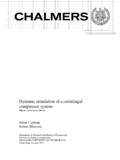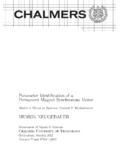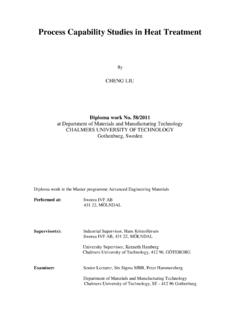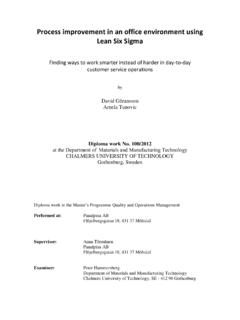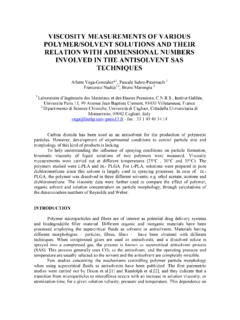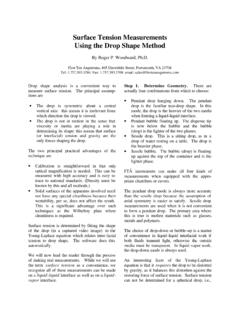Transcription of Solubilization of Organic Dyes in Surfactant Micelles
1 3 Solubilization of Organic dyes in Surfactant Micelles Master of Science Thesis in the Master Degree Programme Materials and Nanotechnology RAJDEEP SINGH Department of Chemical and Biological Engineering Division of Applied Surface Chemistry CHALMERS UNIVERSITY OF TECHNOLOGY Gothenburg, Sweden, 2012 Solubilization of Organic dyes in Surfactant Micelles RAJDEEP SINGH RAJDEEP SINGH, 2012. Department of Chemical and Biological Engineering Division of Applied Surface Chemistry Chalmers University of Technology SE-412 96 G teborg Sweden Telephone: +46 (0)31-772 1000 G teborg, Sweden 2012 Cover: The effect of Surfactant concentration on dye Solubilization (left to right). The Solubilization starts at around critical micelle concentration of each Surfactant and increases almost linearly at higher concentrations. Solubilization of Organic dyes in Surfactant Micelles RAJDEEP SINGH Department of Chemical and Biological Engineering Chalmers University of Technology ABSTRACT In this study, the Solubilization of two Organic dyes , Sudan I (1-Phenylazo-2-naphtol) and Quinizarin (1,4-Dihydroxyanthraquinone), was studied in the presence of different types of surfactants (2 polymerics, 2 nonionics, 2 anionic, and one cationic) using UV-Vis spectroscopy.
2 The effects of temperature, pH and addition of different electrolytes (NaCl, Na2CO3, NaI, NaOH, NaSCN) on dye Solubilization were investigated mainly for Berol 535 (C11EO5), DTAB (C12 quaternary ammonium bromide) and SDS (C12 sodium sulphate). The effect of mixed Micelles of different surfactants (DTAB:Berol 535 and SDS:Berol 535) on dye Solubilization at different concentrations of NaCl was also studied. No synergy effect was observed for the Solubilization of dyes in the binary mixture of Surfactant Micelles . The results showed that the Solubilization of both dyes in the Surfactant Micelles increased with the temperature and addition of salt. However, the anionic Surfactant (SDS) precipitated in the solution at high salt concentration (>20 g/l) and room temperature due to its high Krafft point and this had an adverse effect on dye Solubilization . This was overcome by adding a nonionic Surfactant to the solution or increasing the temperature.
3 The absorbance spectrum of both dyes in Surfactant Micelles was similar to that obtained in ethanol and water/ethanol. This suggested that both dyes are located in rather polar region of the Micelles (palisade region) and close to the surfactants head groups. Keywords: Solubilization , Organic dye, surfactants (cationic, anionic, nonionic, and polymeric), micelle, mixed micelle Table of Contents 1. Introduction .. 1 1 2. Background .. 2 Surfactants .. 2 Micelle formation .. 3 Krafft temperature .. 5 Cloud point .. 6 Solubilization of surfactants .. 6 Mixed Micelles .. 7 Physical-chemical properties .. 9 dyes .. 10 3. Experimental (Materials and methods) .. 11 Materials .. 11 Sudan I (1-Phenylazo-2-naphtol) .. 11 Quinizarin (1,4-Dihydroxyanthraquinone) .. 12 Experimental methods .. 13 Absorption measurement .. 13 Solubilization measurements .. 14 Determine the excess amount of dye.
4 14 CMC measurements .. 15 Krafft temperature .. 15 Cloud point .. 15 Temperature effect .. 15 The effect of pH on Solubilization .. 15 4. Results and Discussion .. 17 Physical-chemical properties of surfactants .. 17 Excess amount of dye .. 19 Solubilization power .. 20 Temperature effect .. 24 Kinetics .. 26 Solubilization in mixed Micelles .. 27 The binary mixture of Berol 535 and DTAB .. 28 The binary mixture of Berol 535 and SDS .. 29 Mixing Berol 535 with SDBS .. 31 Location of dye in micelle .. 32 pH-effect .. 34 Electrolyte effect .. 37 5. Conclusions .. 40 6. Future studies .. 41 7. References .. 42 Acknowledgements .. 45 1 1. Introduction Solubilization of water-insoluble materials in the Surfactant aqueous solution is important in many industrial applications such as detergency, emulsion polymerization, enhanced oil recovery, drug delivery and textile dyeing [1-3].
5 The Surfactant aggregates known as Micelles are responsible for the Solubilization of the hydrophobic substances in water [4]. Therefore, surfactants that start to aggregate into Micelles at low concentrations, are good candidates for this purpose. Among different effective parameters, the effect of temperature and electrolyte concentration on Solubilization is very high. An increase in temperature and addition of electrolytes increases the Solubilization [1]. Objective The aim of this project was to study the effects of the Surfactant chemical structure (anionic, cationic or nonionic), Surfactant concentration, Surfactant mixture, temperature, pH and addition of salt on the Solubilization of the two Organic dyes in aqueous solution. The main objective of this work was to make a systematic study on Solubilization of two Organic dyes (Quinizarin with anthraquinone structure and Sudan I with azo structure) in Surfactant micellar solution.
6 For this reason, a series of surfactants with different types of polar head groups were investigated. The Solubilization of dyes in the mixed Micelles of ionic surfactants with a nonionic Surfactant at different salt concentrations was determined. A minor part of this study deals with the location of the dye molecule in a Surfactant micelle and kinetics of Solubilization . 2 2. Background In this section some background is given regarding surfactants, Solubilization , dyes and instrumental techniques. Surfactants Surface active agents, also known as surfactants, refer to molecules that are active at surfaces. A Surfactant is characterized by its tendency to adsorb at surfaces and interfaces. An interface is a boundary between any two immiscible phases whereas a surface is an interface where one phase is a gas [1,5]. There are five different interfaces: Solid-vapour surface Solid-liquid Solid-solid Liquid-vapour surface Liquid-liquid Since nature always favors lower free energy, one can guess why surfactants adsorb at interfaces.
7 The driving force for a Surfactant to adsorb at an interface is of course to reduce the free energy of that specific phase boundary [5]. Surfactants are amphiphilic molecules consisting of a non-polar, hydrophobic tail and a polar, hydrophilic head group (Figure ). The hydrophobic tail is usually a branched or linear long-chain hydrocarbon residue with a chain length in the range of 8-18 carbon atoms. The polar head group can be either ionic or non-ionic [1,4,5]. Figure A typical illustration of a Surfactant molecule [5] Depending on the charge of the polar head group, surfactants are classified as anionic (negatively charged), cationic (positively charged), zwitterionic (both positively and negatively charged groups) or nonionic (non-charged) [1,4,5]. 3 When a Surfactant is dissolved in an aqueous environment, the hydrophobic tail interacts weakly with the water molecules using van der Waals forces.
8 On the other hand, the hydrophilic head interacts strongly with the water molecules using dipole-dipole or ion-dipole forces. Surfactants are water soluble because of this strong interaction with the water molecules [4]. However, the much weaker van der Waals forces breaks the much stronger hydrogen bonds between water molecules. The surfactants are therefore forced to the interfaces of the system, where the hydrophobic tails get oriented in a way to keep minimum contact with water [1,4]. Micelle formation Surfactants have limits to how much they can lower the surface and interfacial tension. At a certain Surfactant concentration in a system when all interfaces and surfaces are occupied by Surfactant unimers (free Surfactant ), the Surfactant unimers in the bulk start to aggregate into Micelles . This specific concentration is called the critical micelle concentration (CMC). They start to aggregate since they do not want the hydrophobic tails to be in contact with water.
9 So instead Micelles are formed with the hydrophobic tails pointing inwards and the hydrophilic head groups pointing outwards towards the water, as can be seen in Figure In that way the free energy of the system is reduced. Surfactants behave differently depending on if they are present in Micelles or as Surfactant unimers in the solution. Surfactant unimers are the only surface active of the two, so they are the one responsible of decreasing the interfacial and surface tension. Micelles are not surface active. They just act as reservoirs for the surface active Surfactant unimers [5]. Figure A typical illustration of a spherical micelle [5] 4 Micelles are not necessarily spherical as they are usually portrayed. They can also be cylindrical, just a bilayer, reversed etc. It is the critical packing parameter (CPP) that governs the shape of the Micelles . CPP is a dimensionless number defined as: Eq.
10 (1) Where v is the volume of the hydrophobic tail, a is the area of the hydrophobic head and l being the length of the hydrophobic tail. An illustration of CPP can be seen in Figure [5]. Figure The concept of CPP [5] Spherical Micelles will be formed as long as CPP is not higher than 1/3 [4,5]. Figure illustrates how the aggregate structures depend on the CPP. This explains why surfactants with 1) straight hydrophobic tails tend to form spherical Micelles 2) branched hydrophobic tails tend to form cylindrical Micelles which aggregates further into hexagonal structures 3) double hydrophobic tails tend to form lamellar phases and reversed structures Simply the volume of the hydrophobic tails gets larger which leads to a higher CPP [5]. 5 Figure The CPP of different structures [5] Krafft temperature The Krafft temperature, or Krafft point, is the temperature at which the solubility of a Surfactant starts to increase dramatically.


